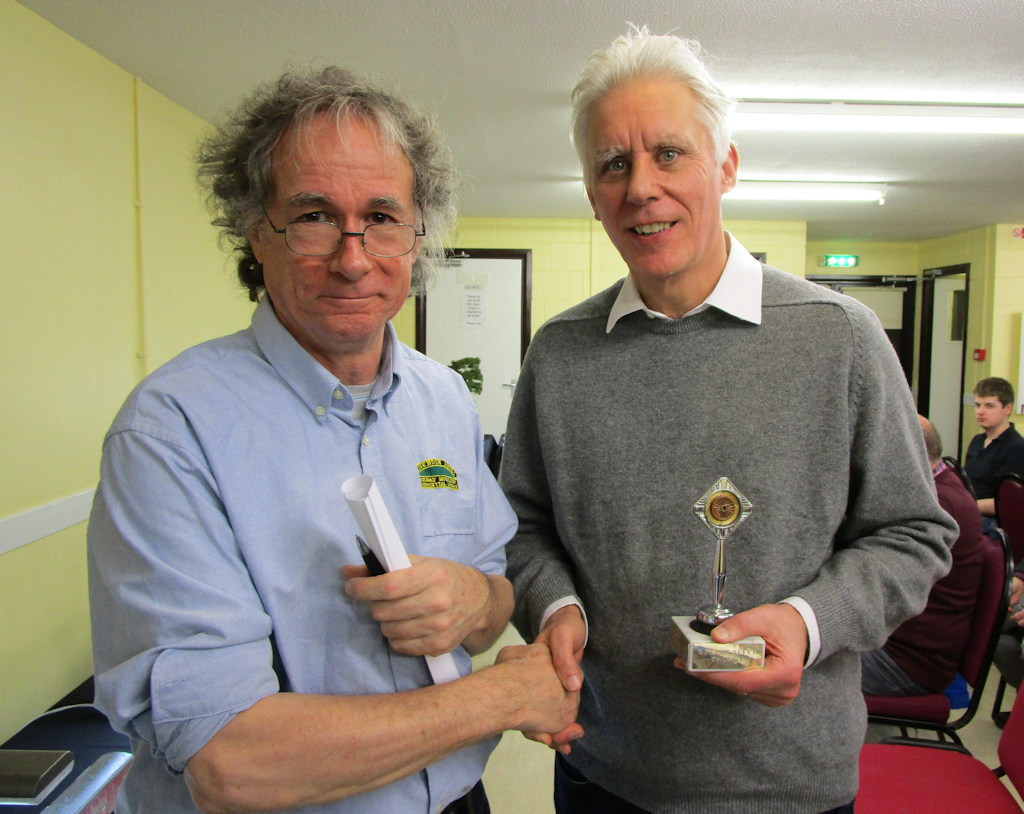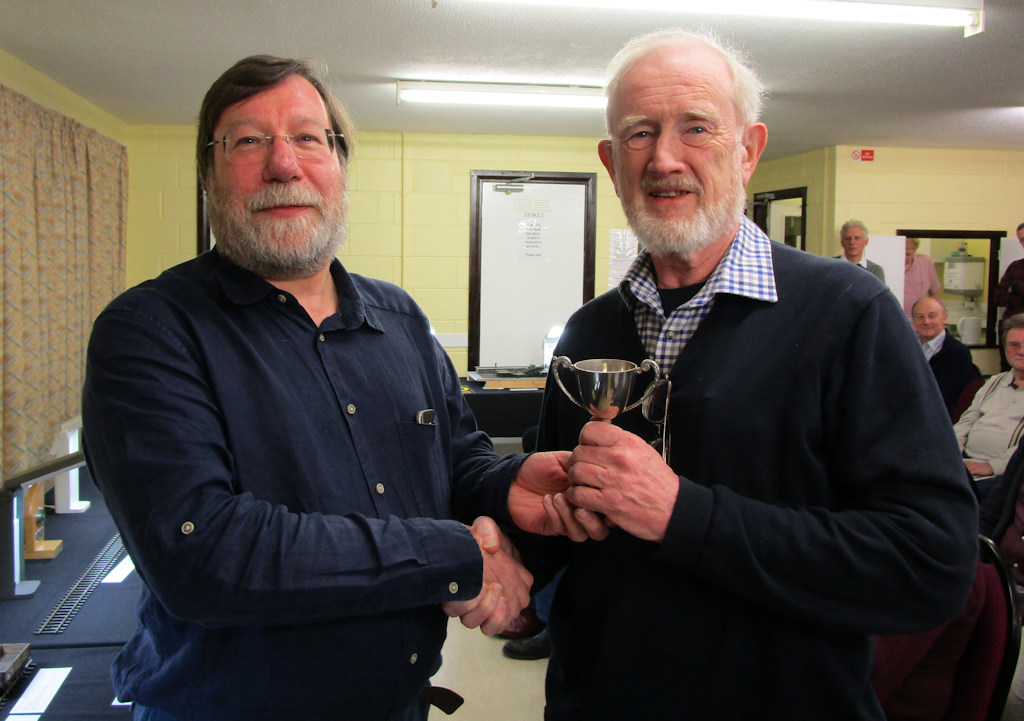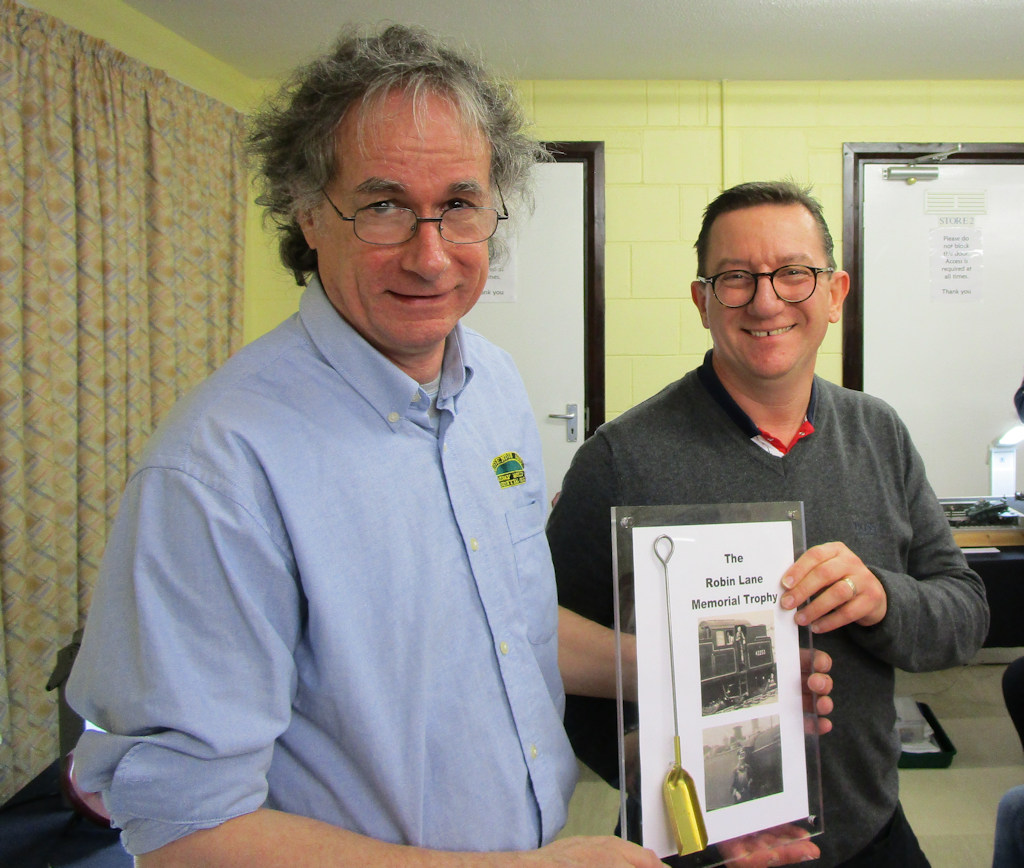Wheeltapper Competition 2018
Wheeltapper 2018 Competition took place on Friday the 9th of February. When invited guest judge and speaker Paul Bambrick, came along to Judge the models on show and then to come up with the overall winner. Paul trades as PJ Bambrick Finescale Modelling and he is well known within modelling circles for his backscenes and dioramas. For further details visit Bambrick Studios
Wheeltapper Trophy
Roy Norton (right) receiving the Wheeltapper Trophy from Paul Bambrick for his Southern Railway N1 2-6-0 Locomotive a 3 cylinder mixed traffic locomotive, introduced by Richard Maunsell for the SECR in 1922, based on the two cylinder N class loco. The slab fronted running plate was required to clear the original Holcroft conjugated vale gear - later replaced by conventional Walschaerts gear. Five further locos were outshopped in 1930 for the SR.
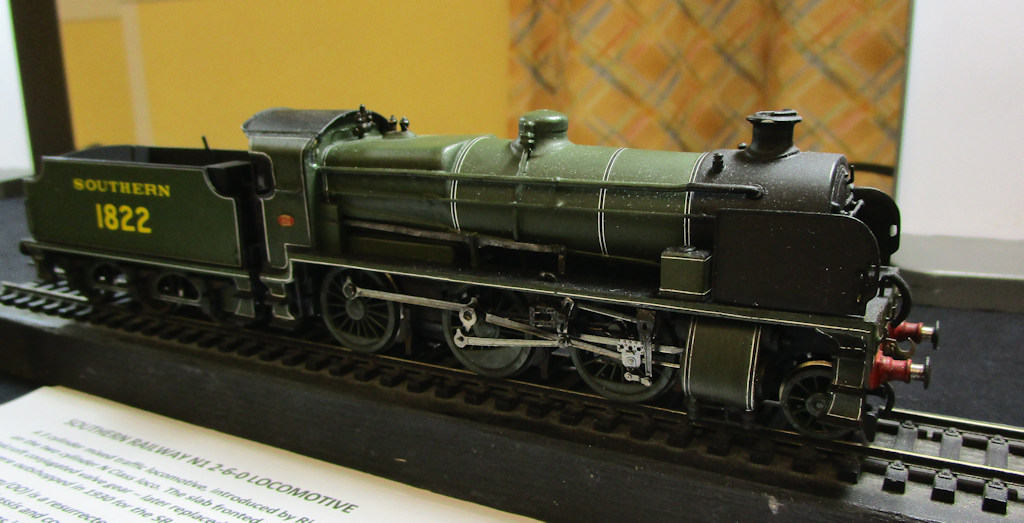 The model (4mm/OO) is a resurrected, detailed Wills N Class whitemetal body, on a modified Bachmann N Class chassis and coupled to a rescued Hornby SR 3500 gal. tender. It represents the prototype N1- No.1822 - as it would have appeared in the late 1930s.
The model (4mm/OO) is a resurrected, detailed Wills N Class whitemetal body, on a modified Bachmann N Class chassis and coupled to a rescued Hornby SR 3500 gal. tender. It represents the prototype N1- No.1822 - as it would have appeared in the late 1930s.
Chairman’s Cup
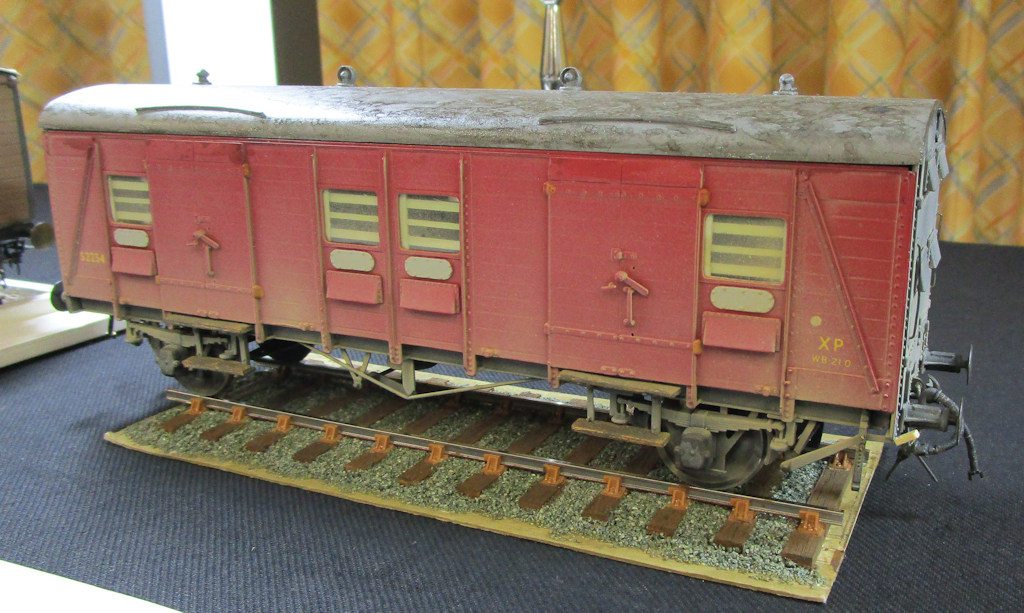 Built from a Slaters kit to S7 Standards, depicts vehicle as it would have been in the early 1950, after repainting 18 months earlier.
Built from a Slaters kit to S7 Standards, depicts vehicle as it would have been in the early 1950, after repainting 18 months earlier.
Steam Locomotives
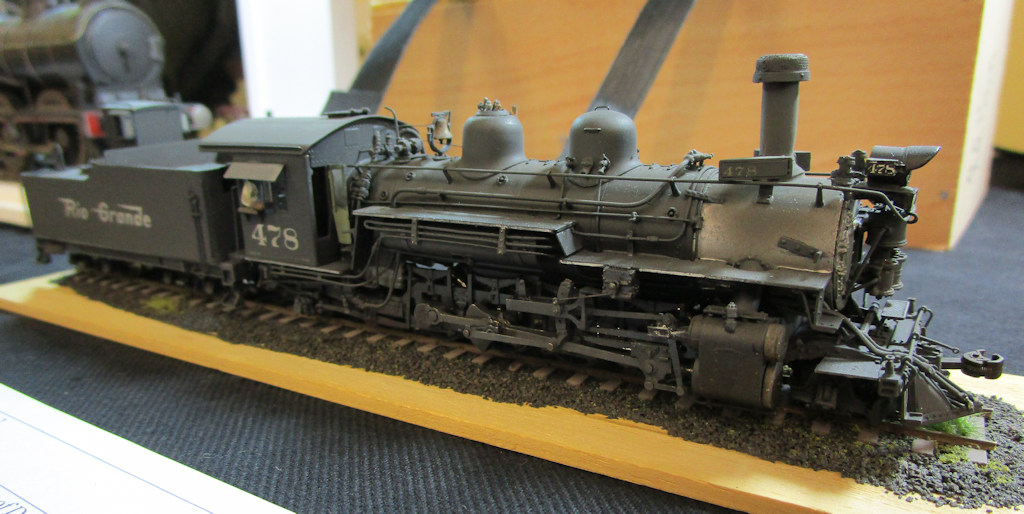 The winner of the Steam Locomotives competition was Mick Moignard for his D&RGW K-28 #478 HOn3. #478 is a 3-foot gauge locomotive, still in use out of Durango, Colorado on the Silverton line. The model, running on 10.5mm gauge rack, is based on a Precision Scale Co brass generic K-28 model. It has been re-detailed with many extra parts and changes to represent 478 as it was in early 1951. Extra details include a new bell, fuse box on the LH smokebox side, tender doghouse, along with many and various piping changes, and even includes water in the tender under the water hatch. All is soldered using both iron and RSU. The model was cleaned and painted, weathered with various paint, wash and powder techniques. It is fitted with DCC sound and lights, including a light in the doghouse.
The winner of the Steam Locomotives competition was Mick Moignard for his D&RGW K-28 #478 HOn3. #478 is a 3-foot gauge locomotive, still in use out of Durango, Colorado on the Silverton line. The model, running on 10.5mm gauge rack, is based on a Precision Scale Co brass generic K-28 model. It has been re-detailed with many extra parts and changes to represent 478 as it was in early 1951. Extra details include a new bell, fuse box on the LH smokebox side, tender doghouse, along with many and various piping changes, and even includes water in the tender under the water hatch. All is soldered using both iron and RSU. The model was cleaned and painted, weathered with various paint, wash and powder techniques. It is fitted with DCC sound and lights, including a light in the doghouse.
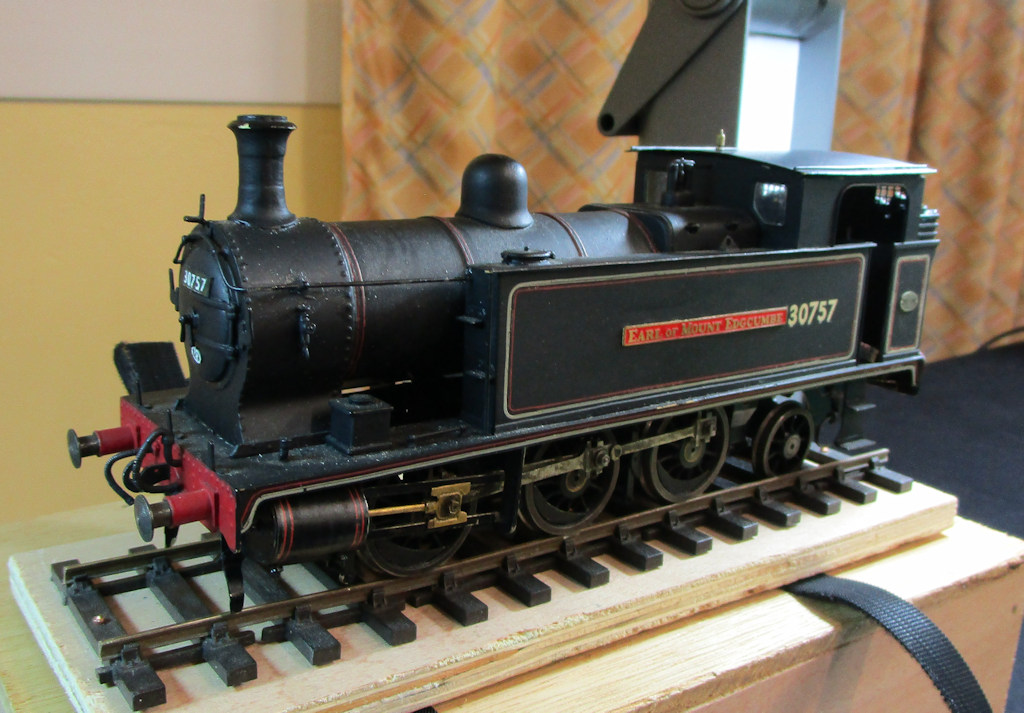 Another entry in the steam locomotives category was Adrian Harford's Former PD&SWJR 0-6-2T 30757 'Earl of Mount Edgcumbe'. Adrian states that this is 'Mister reliable' of his locos. It is an Agenoria kit which succeeded serval other Agenoria kit builds on the shaky grounds that it could have passed through Okehampton. It was later used on the Calstock branch but was originally a Plymouth harbour engine, bearing the name, presumably, of a local dignitary who was Chairman of the harbour company (and was probably also a GWR board member to get his title on to a Castle class engine).
Another entry in the steam locomotives category was Adrian Harford's Former PD&SWJR 0-6-2T 30757 'Earl of Mount Edgcumbe'. Adrian states that this is 'Mister reliable' of his locos. It is an Agenoria kit which succeeded serval other Agenoria kit builds on the shaky grounds that it could have passed through Okehampton. It was later used on the Calstock branch but was originally a Plymouth harbour engine, bearing the name, presumably, of a local dignitary who was Chairman of the harbour company (and was probably also a GWR board member to get his title on to a Castle class engine).
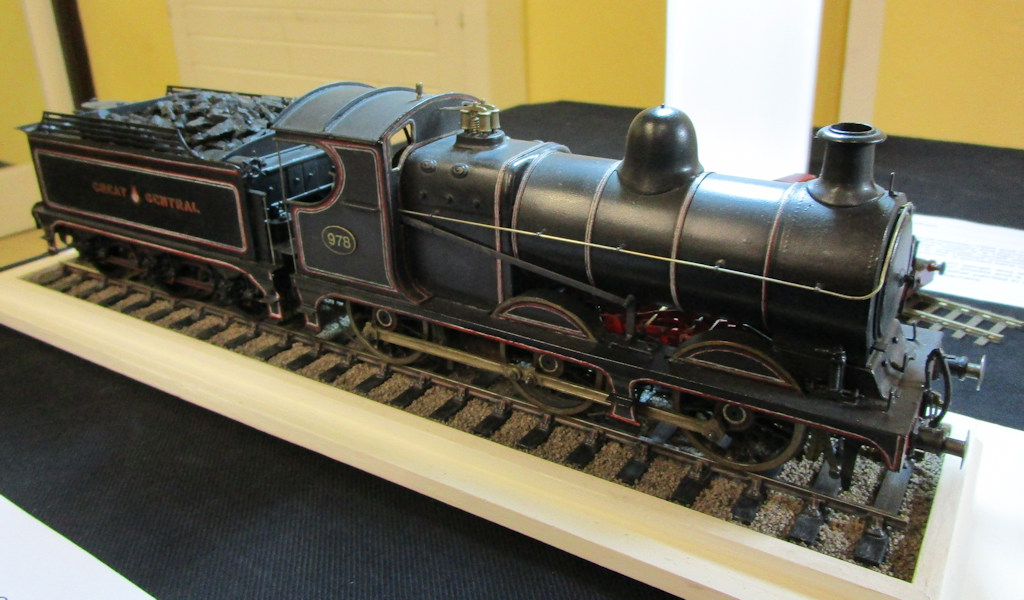 A further entry in this category was Chris Andrew's GCR 9J (LNER J11) 0-6-0 (Pom Pom). The Pom Poms were J.G. Robinson's first design for the Great Central Railway. No 978 was one of the first batch built by Neilson, Reid and Co. in 1902. Some of these general purpose medium good engines were based locally at Neasden and Woodford and worked the joint lines. The model is a David Andrews etched brass and nickel silver kit in 7mm finescale with Slaters wheels, Mashima motor and added detail. Early features include rerailing jacks both side of the footplate, Ramsbottom safety valves, tender coal rails and Robinson's tender 'shipwheel' for controlling the water scoop. Finished in GCE black loco livery with gentle weathering representing a well kept engine in the Edwardian era.
A further entry in this category was Chris Andrew's GCR 9J (LNER J11) 0-6-0 (Pom Pom). The Pom Poms were J.G. Robinson's first design for the Great Central Railway. No 978 was one of the first batch built by Neilson, Reid and Co. in 1902. Some of these general purpose medium good engines were based locally at Neasden and Woodford and worked the joint lines. The model is a David Andrews etched brass and nickel silver kit in 7mm finescale with Slaters wheels, Mashima motor and added detail. Early features include rerailing jacks both side of the footplate, Ramsbottom safety valves, tender coal rails and Robinson's tender 'shipwheel' for controlling the water scoop. Finished in GCE black loco livery with gentle weathering representing a well kept engine in the Edwardian era.
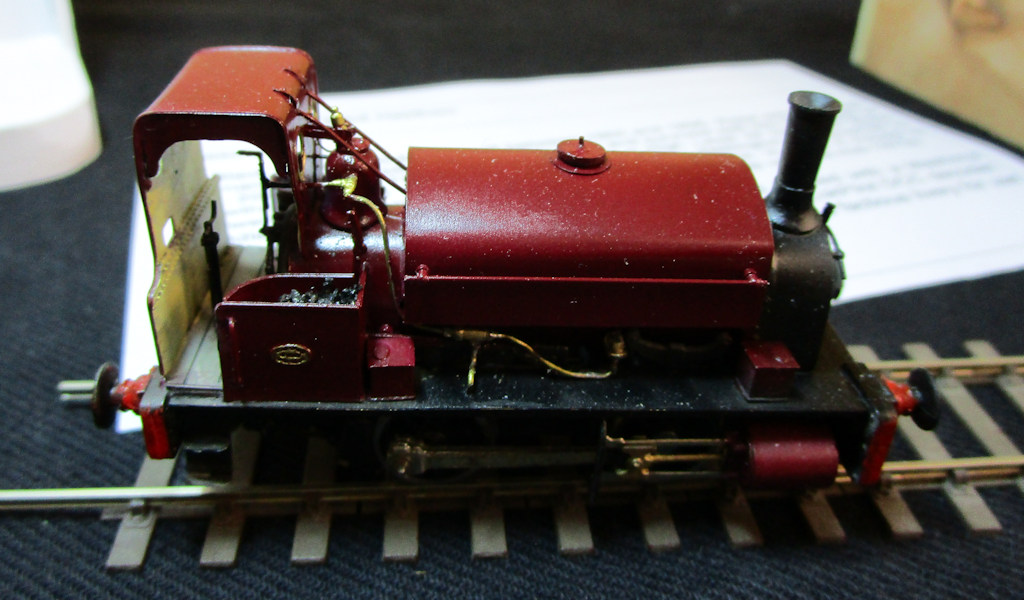 A final entry in this category was Mark Riddoch's Black Hawthorn 0-4-0ST, built between 1865 and 1896. These were supplied to many industrial sites around the country and survived well in to the middle of the 20th century. This particular model is a High Level kit based in Black Hawthorn No. 226 built in 1873, originally named Wellington but renamed to Holwell No. 3 when it moved to Holwell Ironworks. In 1946 it moved to Middle Peaks quarry near Winksworth, it worked there up until the mid-1970s. The model is in 4mm scale to OO gauge and is fitted with a Mashima 1224 motor, 3 foot diameter Alan Gibson wheels and a LokPilot DCC decoder. It is not depicted as Holwell No 3, but in a fictitious livery for use on a layout that is currently under development.
A final entry in this category was Mark Riddoch's Black Hawthorn 0-4-0ST, built between 1865 and 1896. These were supplied to many industrial sites around the country and survived well in to the middle of the 20th century. This particular model is a High Level kit based in Black Hawthorn No. 226 built in 1873, originally named Wellington but renamed to Holwell No. 3 when it moved to Holwell Ironworks. In 1946 it moved to Middle Peaks quarry near Winksworth, it worked there up until the mid-1970s. The model is in 4mm scale to OO gauge and is fitted with a Mashima 1224 motor, 3 foot diameter Alan Gibson wheels and a LokPilot DCC decoder. It is not depicted as Holwell No 3, but in a fictitious livery for use on a layout that is currently under development.
Coaching Stock and NPCS
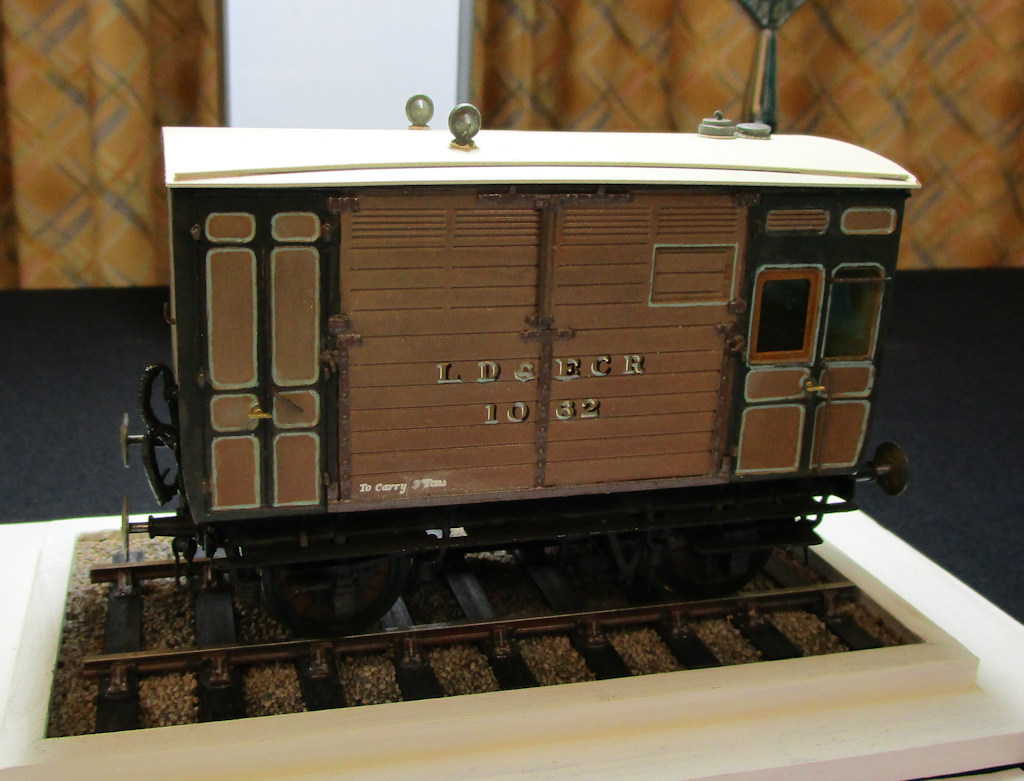 The winner of the Coaching Stock and NPCS competition was Chris Andrew for his Lancashire, Derbyshire and East Coast Railway Horse Box. One of 4 built by the Lancaster Carriage and Wagon Works in 1897, based on a Great Eastern Railway design. The Great Central Railway absorbed the LD&ECR in 1907. It is not certain that these horse boxes ever received the GCR insignia. The model is a D&S etched brass kit in 7mm finescale with Slaters and added details. Finished in LD&ECR livery with gentle weathering representing its early condition.
The winner of the Coaching Stock and NPCS competition was Chris Andrew for his Lancashire, Derbyshire and East Coast Railway Horse Box. One of 4 built by the Lancaster Carriage and Wagon Works in 1897, based on a Great Eastern Railway design. The Great Central Railway absorbed the LD&ECR in 1907. It is not certain that these horse boxes ever received the GCR insignia. The model is a D&S etched brass kit in 7mm finescale with Slaters and added details. Finished in LD&ECR livery with gentle weathering representing its early condition.
Freight and Engineers Stock
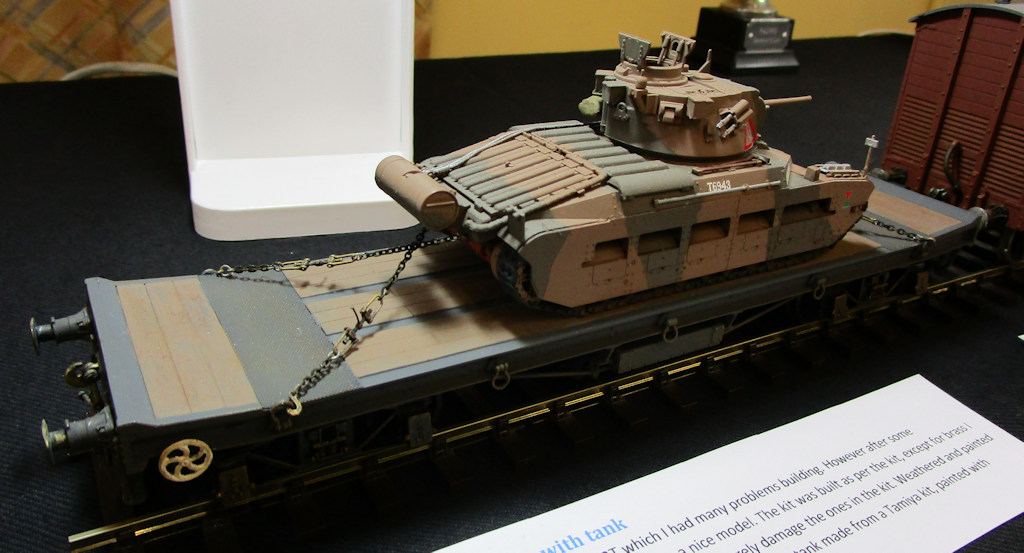 The winner of the Freight and Engineers Stock competition was James Aitken for his Rectank Wagon with Tank. The rectank is a kit from JLTRT which he had many problems building. However after some perseverance it has turned out to be a nice model. The kit was built as per the kit, except for brass I beams under the floor as he managed to severely damage the ones in the kit. Weathered and painted using Precision paints. The tank is a British Matilda tank made from a Tamiya kit, painted with Tamiya acrylics using an aribrush. It is 1/48th scale.
The winner of the Freight and Engineers Stock competition was James Aitken for his Rectank Wagon with Tank. The rectank is a kit from JLTRT which he had many problems building. However after some perseverance it has turned out to be a nice model. The kit was built as per the kit, except for brass I beams under the floor as he managed to severely damage the ones in the kit. Weathered and painted using Precision paints. The tank is a British Matilda tank made from a Tamiya kit, painted with Tamiya acrylics using an aribrush. It is 1/48th scale.
There were several other entries for this particular category including the following:
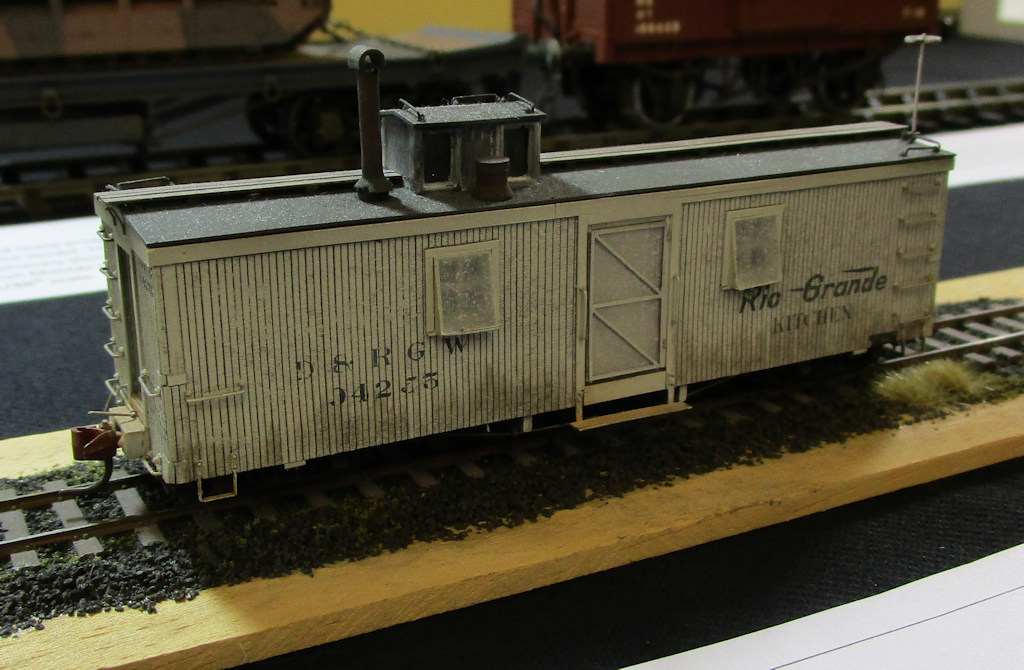 This entry is Mick Moignard's D&RGW #04255 Kitchen Outfit – HOn3. #04255 was the Kitchen car in the support train for Rotary Snowplow OM based in Chama, NM on the D&RGW’s Cumbres pass line. The model uses the body parts from a Narrow Gauge Colorado laser cut kit featuring a 3d printed cupola. Other detail parts have been replaced or upgraded from those in the kit. It is finished in the post-war grey livery as it was in 1951 and weathered from photos.
This entry is Mick Moignard's D&RGW #04255 Kitchen Outfit – HOn3. #04255 was the Kitchen car in the support train for Rotary Snowplow OM based in Chama, NM on the D&RGW’s Cumbres pass line. The model uses the body parts from a Narrow Gauge Colorado laser cut kit featuring a 3d printed cupola. Other detail parts have been replaced or upgraded from those in the kit. It is finished in the post-war grey livery as it was in 1951 and weathered from photos.
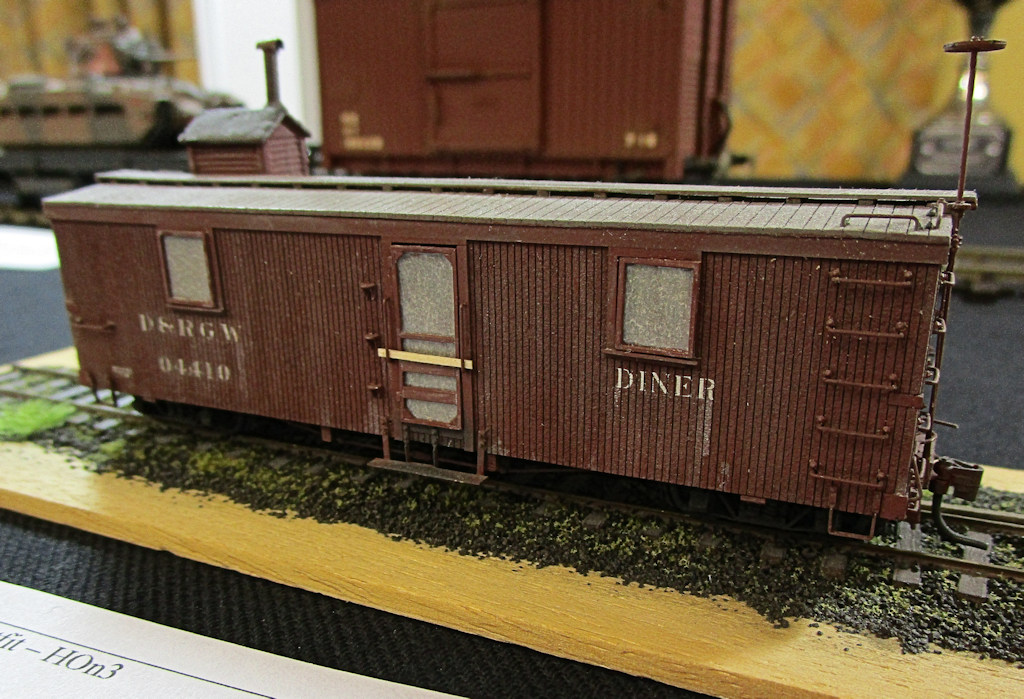 This is Mick Moignard's D&RGW #04410 Diner Outfit – HOn3. #04410 Diner was one of a string of three outfit cars used at Monarch, Colorado as facilities for the section crew based there. 04410 is based on the main body parts from a Narrow Gauge Colorado laser-cut wooden kit. Most of the detail parts in the kit were replaced or upgraded. Additions include the complete brake gear under the car, and all the bodyside details, steps and so on. It’s painted as it was around 1951, weathered from available photos, and runs on Grandt Line 10.5mm gauge trucks with Kadee couplers.
This is Mick Moignard's D&RGW #04410 Diner Outfit – HOn3. #04410 Diner was one of a string of three outfit cars used at Monarch, Colorado as facilities for the section crew based there. 04410 is based on the main body parts from a Narrow Gauge Colorado laser-cut wooden kit. Most of the detail parts in the kit were replaced or upgraded. Additions include the complete brake gear under the car, and all the bodyside details, steps and so on. It’s painted as it was around 1951, weathered from available photos, and runs on Grandt Line 10.5mm gauge trucks with Kadee couplers.
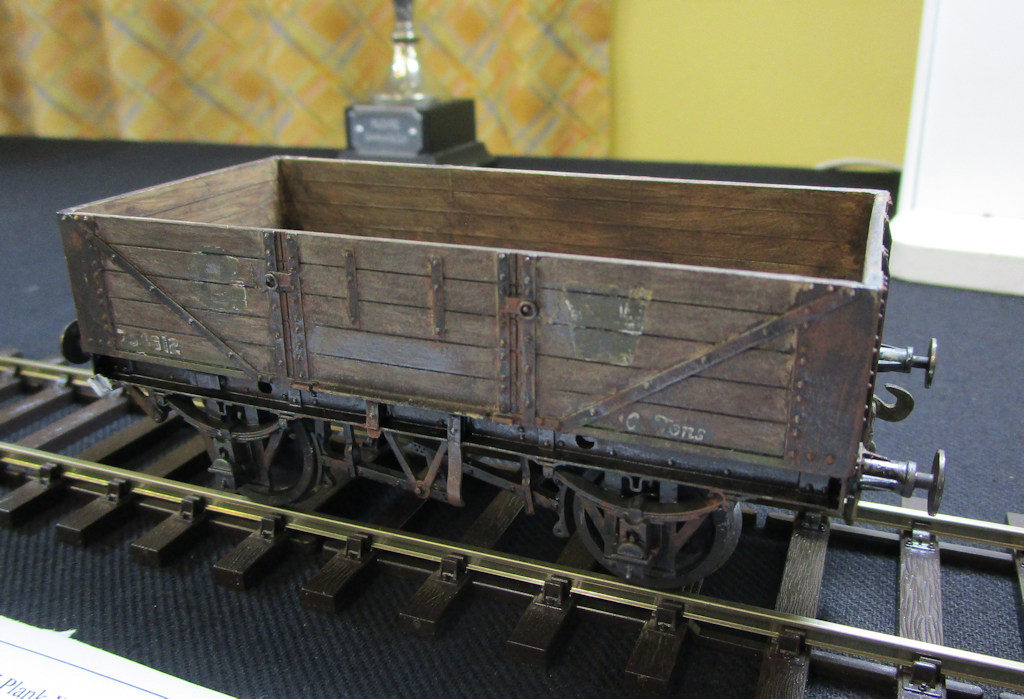 This is Ian Gearing's 7mm GWR Dia 02 5plank Wagon. This is a Coopercraft plastic kit, Parkside Dundas sprung buffers, Wagon originally painted in GWR grey, repainted in wood. Lettering/numbering masked before painting then fiberglass brush over to create a worn affect, painted in Lifecolor acrylics.
This is Ian Gearing's 7mm GWR Dia 02 5plank Wagon. This is a Coopercraft plastic kit, Parkside Dundas sprung buffers, Wagon originally painted in GWR grey, repainted in wood. Lettering/numbering masked before painting then fiberglass brush over to create a worn affect, painted in Lifecolor acrylics.
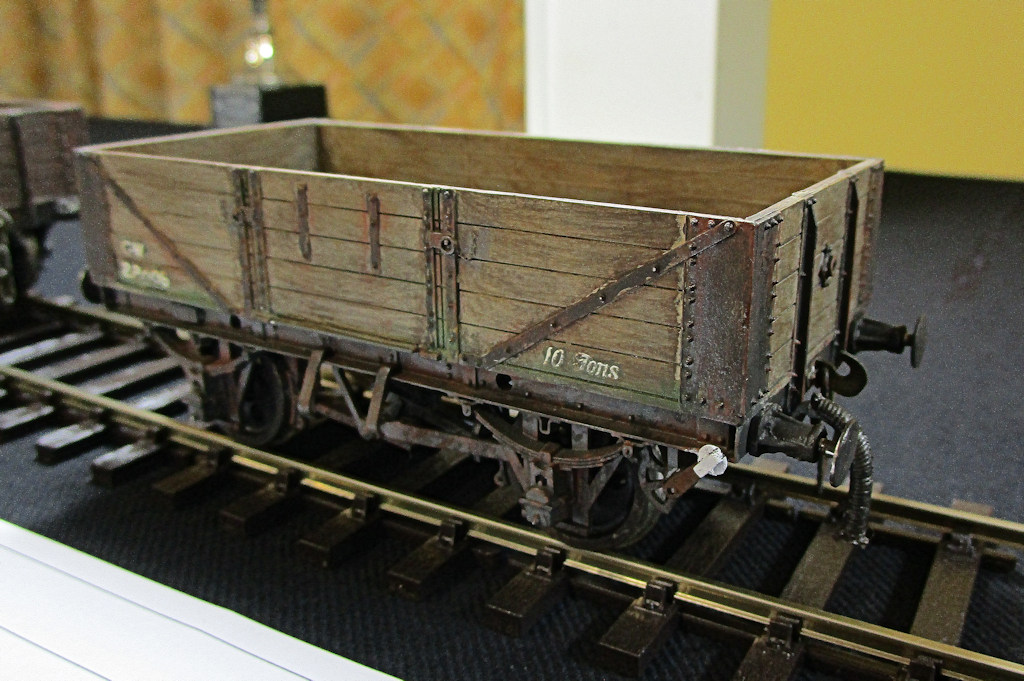 This is Ian Gearing's 7mm GWR Dia 04 5plank Wagon. This is another Coopercraft plastic kit, Parkside Dundas sprung buffers, Wagon originally painted in GWR grey, repainted in wood. Lettering/numbering masked before painting then fiberglass brush over to create a worn affect, painted in Lifecolor acrylics.
This is Ian Gearing's 7mm GWR Dia 04 5plank Wagon. This is another Coopercraft plastic kit, Parkside Dundas sprung buffers, Wagon originally painted in GWR grey, repainted in wood. Lettering/numbering masked before painting then fiberglass brush over to create a worn affect, painted in Lifecolor acrylics.
Finally, this entry is James Aitken's North Eastern Fruit Van. Made from a Connoisseur brass kit with Slaters wheels, he replaced the roof as the thin brass supplied did not look right. The new roof is made from thin plastic sheet curved using an oven! A rocking axle is fitted at one end to help keep all 4 wheels on the track. Buffers have been replaced by Parkside buffers with his own springing system inside. The screw couplings come from spare parts left over from a JLTRT Warwell kit.
Road Vehicles, Boats, People, Animals etc
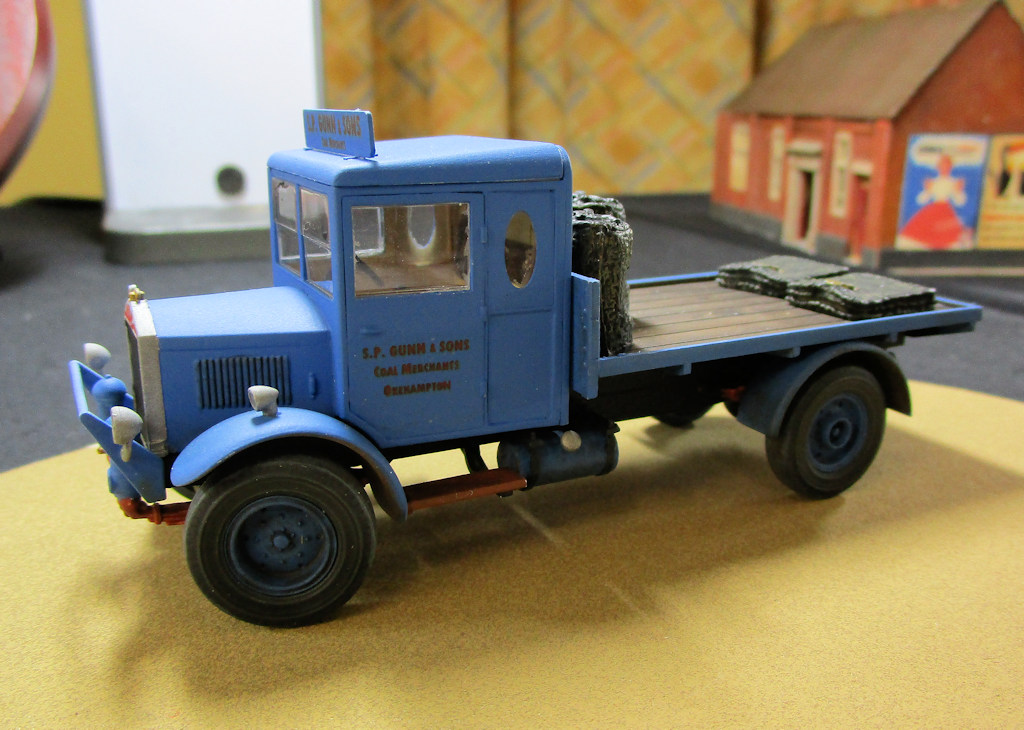 The winner of The Robbie Robinson Award for road vehicles, boats, people, and animals was Paul Wright for his SP Gunn Coal Lorry 1:43. The model is based on an Airfix kit for the AM463 refueler. He used the chassis with the bonnet and cab front, added a new fuel tank and driver side step. The cab has been heavily modified by changing the shape to be a squarer and narrower with new panels cut on the club's laser cutter. The flat bed is scratch built and the coal sacks are from S&D Models kit. The model will be installed on Okehampton when the SP Gunn coal yard is built.
The winner of The Robbie Robinson Award for road vehicles, boats, people, and animals was Paul Wright for his SP Gunn Coal Lorry 1:43. The model is based on an Airfix kit for the AM463 refueler. He used the chassis with the bonnet and cab front, added a new fuel tank and driver side step. The cab has been heavily modified by changing the shape to be a squarer and narrower with new panels cut on the club's laser cutter. The flat bed is scratch built and the coal sacks are from S&D Models kit. The model will be installed on Okehampton when the SP Gunn coal yard is built.
Scenic Models: Buildings, Trees, Signals etc
 The winner of the Jack Cline Trophy for Scenic Models: Buildings, Trees and Signals was David Lane for his Aylesbury Town Main Station Building. This is a 4mm = 1ft scratch built model. It started out as a 3D Computer aided design which was turned into a series of 2D files for the club’s laser cutter. Additional 3D printed parts were added. The model was painted and weathered with Humbrol Paints.
The winner of the Jack Cline Trophy for Scenic Models: Buildings, Trees and Signals was David Lane for his Aylesbury Town Main Station Building. This is a 4mm = 1ft scratch built model. It started out as a 3D Computer aided design which was turned into a series of 2D files for the club’s laser cutter. Additional 3D printed parts were added. The model was painted and weathered with Humbrol Paints.
There were several other entries for this particular category including the following:
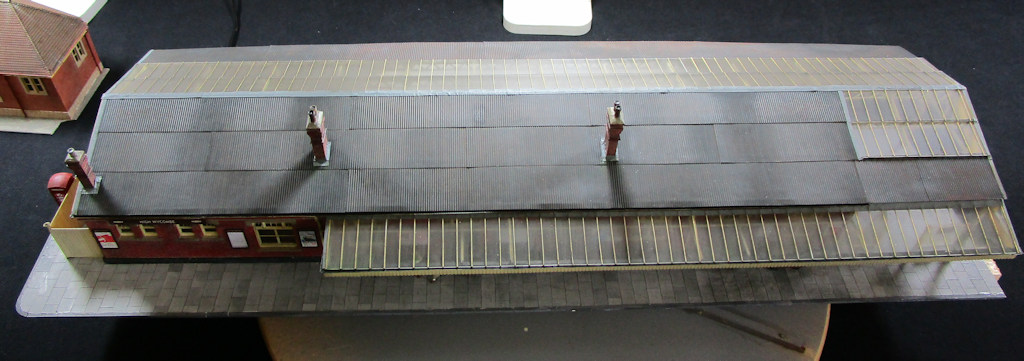
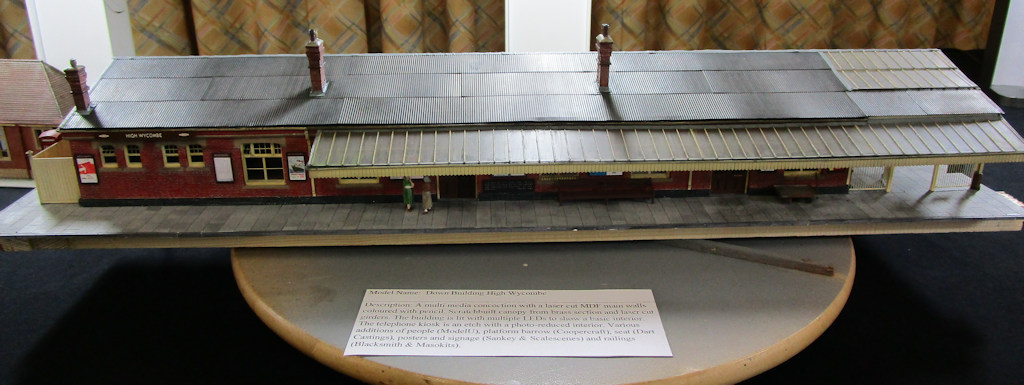 This is Tim Peacock's Down Building High Wycombe. A multi media concoction with a laser cut MDF main walls coloured with pencil. Scratchbuilt canopy from brass section and laser cut girders. The building is lit my multiple LEDs to show a basic interior. the telephone kiosk is an etch with a photo-reduced interior. Various additions of people (Modelu), platform barrow (Coopercraft), seat (Dart Castings), posters and signage (Sankey & Scalescenes) and railings (Blacksmith & Masokits).
This is Tim Peacock's Down Building High Wycombe. A multi media concoction with a laser cut MDF main walls coloured with pencil. Scratchbuilt canopy from brass section and laser cut girders. The building is lit my multiple LEDs to show a basic interior. the telephone kiosk is an etch with a photo-reduced interior. Various additions of people (Modelu), platform barrow (Coopercraft), seat (Dart Castings), posters and signage (Sankey & Scalescenes) and railings (Blacksmith & Masokits).
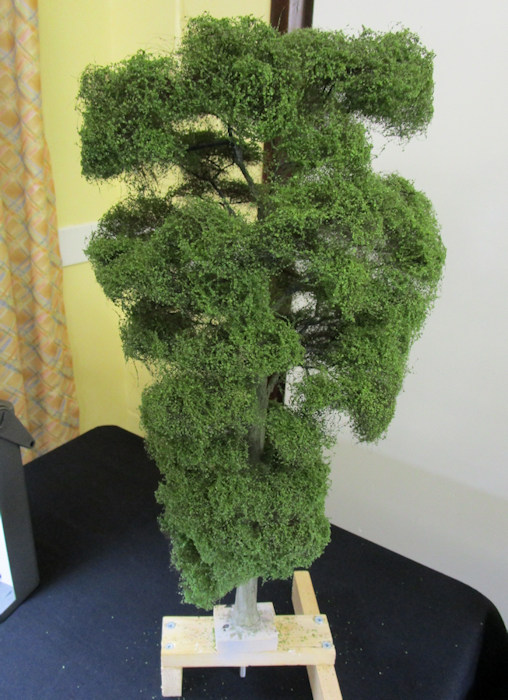 This is Paul Wright's Elm Tree 1:43. It is an elm tree constructed for the club’s Okehampton layout. It has a 6mm stainless steel threaded rod as the main support with branches made from florist's wire. This has been is covered with wood filler to bulk out the trunk and then an acrylic paste to form the bark. It has been painted with acrylic paint and washes with foliage which can be obtained from various sources.
This is Paul Wright's Elm Tree 1:43. It is an elm tree constructed for the club’s Okehampton layout. It has a 6mm stainless steel threaded rod as the main support with branches made from florist's wire. This has been is covered with wood filler to bulk out the trunk and then an acrylic paste to form the bark. It has been painted with acrylic paint and washes with foliage which can be obtained from various sources.
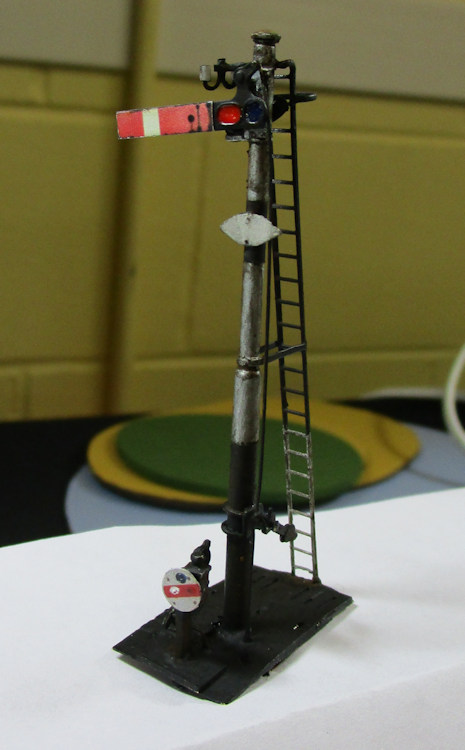 This is Roy Norton's Semaphore Signal (Aylesbury circa 1960). This is a model of a BR(MR) round post, upper quadrant signal and a BR (ex LNER) ground signal. The prototype controlled the exit from Aylesbury loco yard. This is the first signal for the Club's Aylesbury Town(P4) layout. It was a test bed for the construction of the dozen or so signals required for the layout. It is interesting not just because of the ground signal but also because it doubled as a telegraph pole - note the two insulators near the top of the post. The signals were made from a selection of brass/NS tube, rod, channel and wire plus some etches and castings. The ground signal, in particular, really tested Roy’s soldering skills and his eyesight! It all works and will be operated by under-board servos.
This is Roy Norton's Semaphore Signal (Aylesbury circa 1960). This is a model of a BR(MR) round post, upper quadrant signal and a BR (ex LNER) ground signal. The prototype controlled the exit from Aylesbury loco yard. This is the first signal for the Club's Aylesbury Town(P4) layout. It was a test bed for the construction of the dozen or so signals required for the layout. It is interesting not just because of the ground signal but also because it doubled as a telegraph pole - note the two insulators near the top of the post. The signals were made from a selection of brass/NS tube, rod, channel and wire plus some etches and castings. The ground signal, in particular, really tested Roy’s soldering skills and his eyesight! It all works and will be operated by under-board servos.
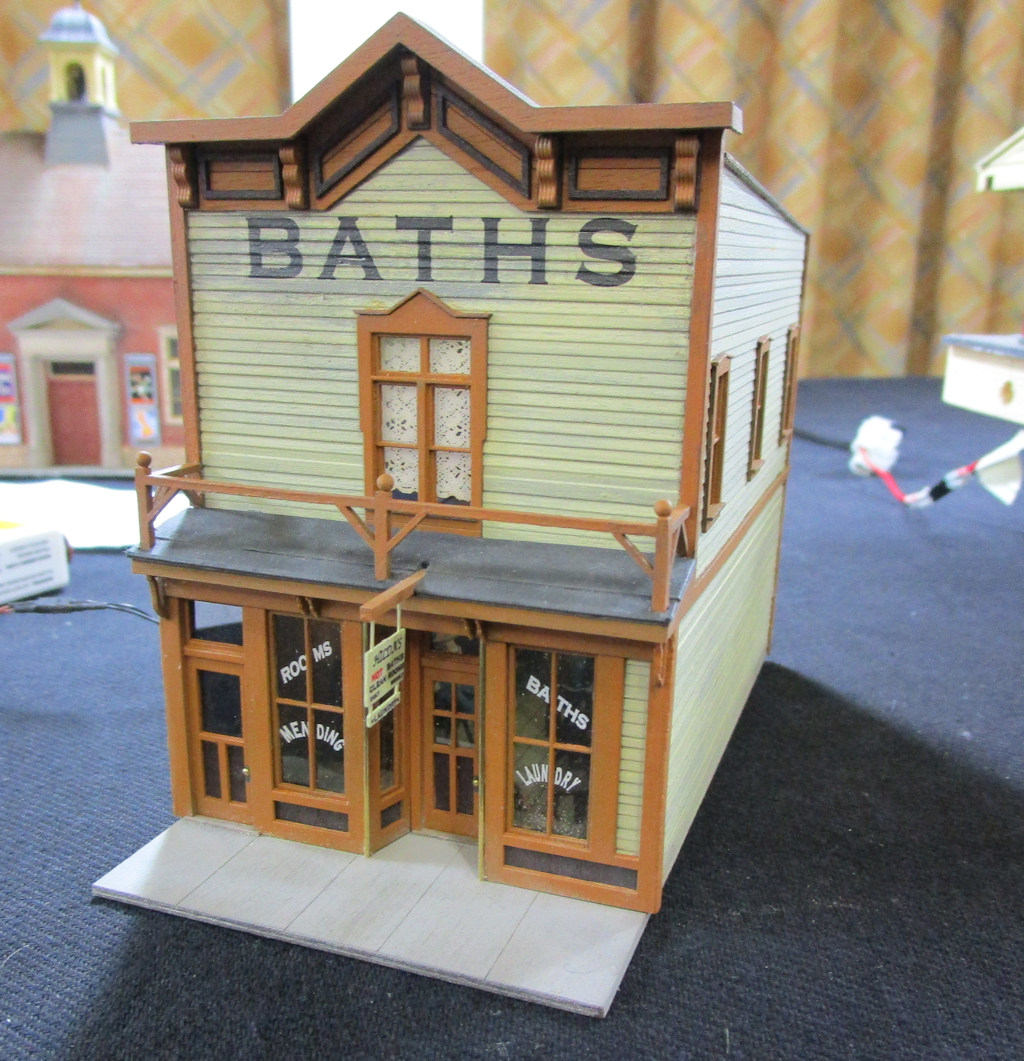 This is Mick Moignard's Telluride Bath House, HO Scale. It is a model of the “Baths” building in Telluride, Colorado, as it was around 1951, and used as a café as well as a Laundry, rooms and bath house. The model is built from a Raggs To Riches laser cut wood kit, and has been equipped with a lighting system and a complete interior in the café area. The upstairs lights are set to go on and off at random.
This is Mick Moignard's Telluride Bath House, HO Scale. It is a model of the “Baths” building in Telluride, Colorado, as it was around 1951, and used as a café as well as a Laundry, rooms and bath house. The model is built from a Raggs To Riches laser cut wood kit, and has been equipped with a lighting system and a complete interior in the café area. The upstairs lights are set to go on and off at random.
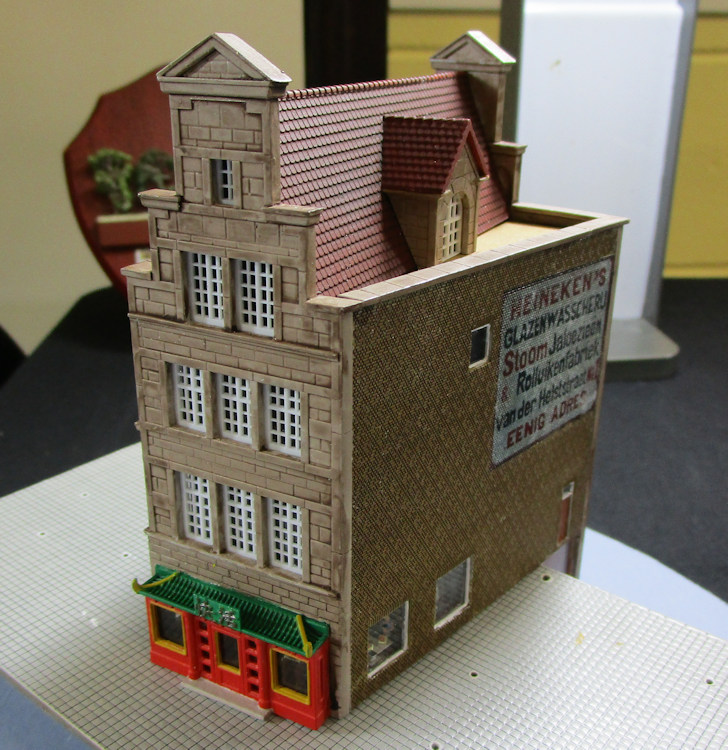 This is Paul Wright's Chinese Restaurant 1:160. It has been built using parts from a Kibri kit combined with parts produced on the Club's laser cutter to get the diamond brick work and 3D printed front section. It has a scratch built interior. The wall painting of the bottles and the advertisement are homemade decals. This is the end of the row of canal side buildings based on those in Utrecht. The next two buildings are complete which leaves about five more buildings to complete the row.
This is Paul Wright's Chinese Restaurant 1:160. It has been built using parts from a Kibri kit combined with parts produced on the Club's laser cutter to get the diamond brick work and 3D printed front section. It has a scratch built interior. The wall painting of the bottles and the advertisement are homemade decals. This is the end of the row of canal side buildings based on those in Utrecht. The next two buildings are complete which leaves about five more buildings to complete the row.
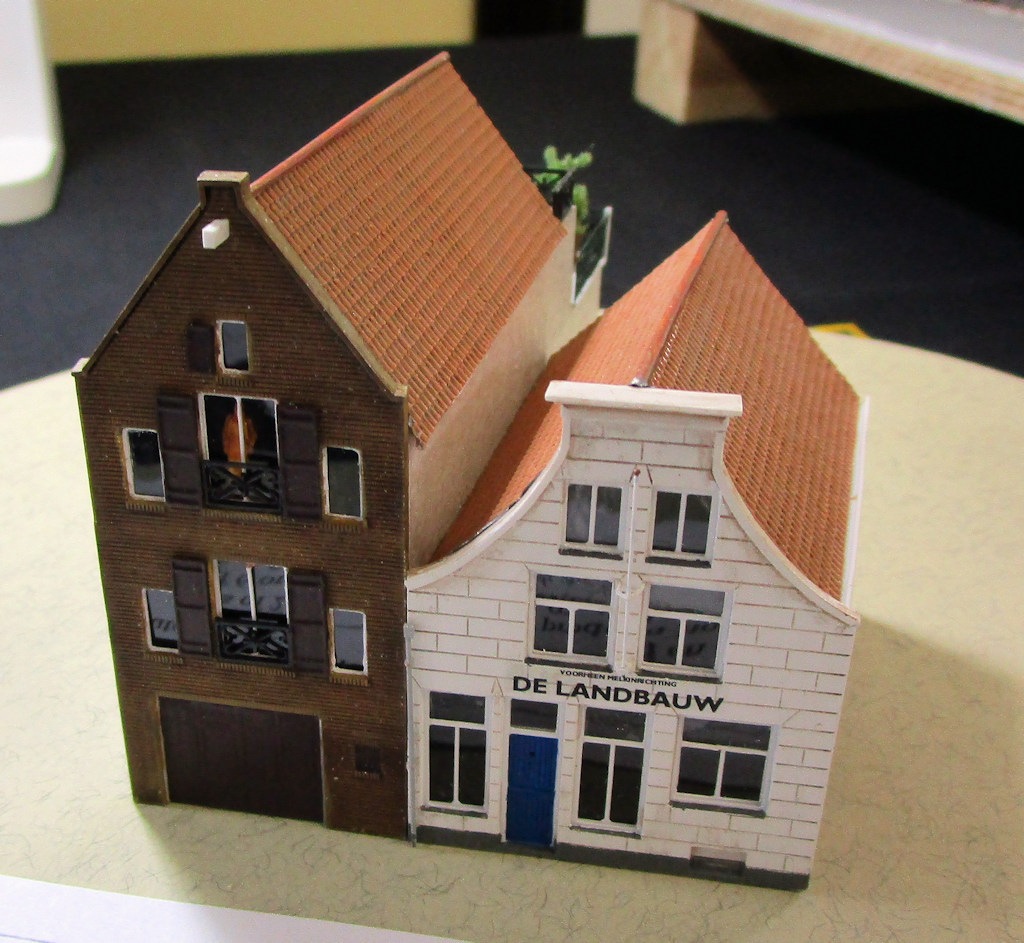 This is Paul Wright's Dutch Buildings 1:160. The model is a scratch built copy of two buildings from Delft which have been produced on the club’s laser cutter. The front face has been made up of six or seven layers to get the 3D effect, with homemade decals on the white building. The roof tiles are by Redutex and the lead flashing is thin lead strip.
This is Paul Wright's Dutch Buildings 1:160. The model is a scratch built copy of two buildings from Delft which have been produced on the club’s laser cutter. The front face has been made up of six or seven layers to get the 3D effect, with homemade decals on the white building. The roof tiles are by Redutex and the lead flashing is thin lead strip.
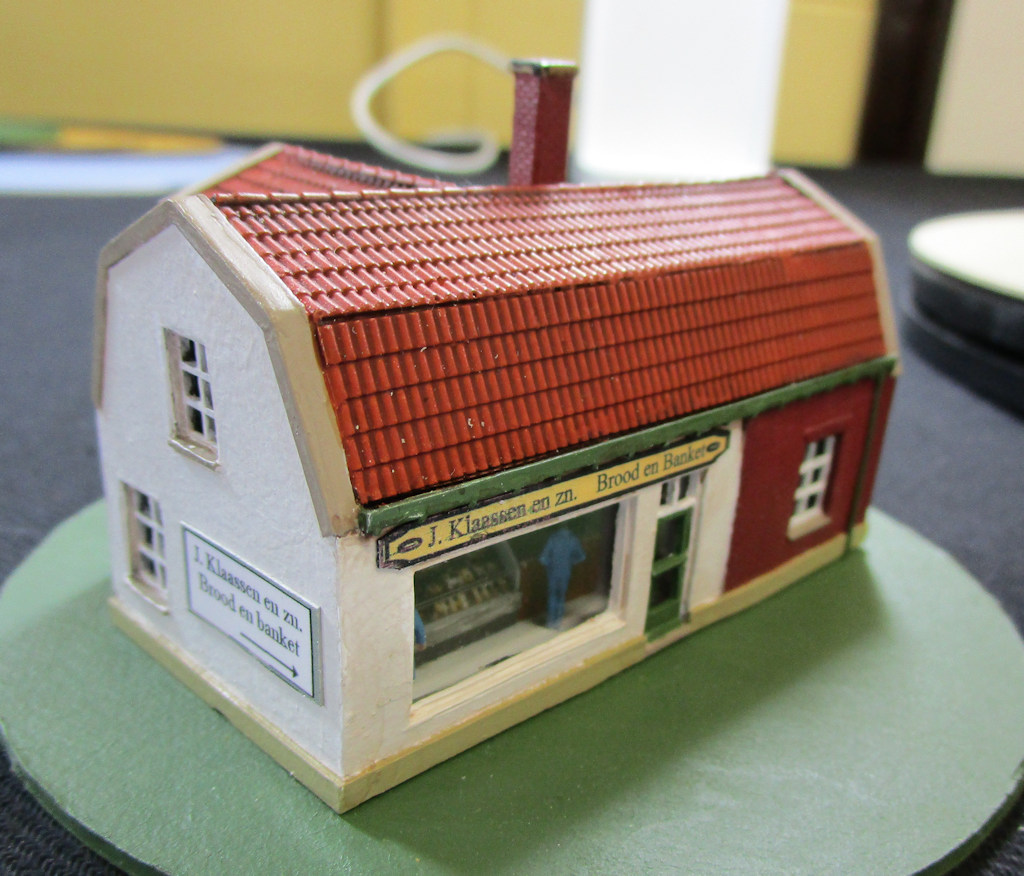 This is Paul Wright's Dutch Bakery 1:160, which has been built from a Tilly Models resin kit. This requires a lot of filling and filing to get everything to fit but looks OK when done. Painted in acrylics with a scratch built interior.
This is Paul Wright's Dutch Bakery 1:160, which has been built from a Tilly Models resin kit. This requires a lot of filling and filing to get everything to fit but looks OK when done. Painted in acrylics with a scratch built interior.
Dioramas & Figurines
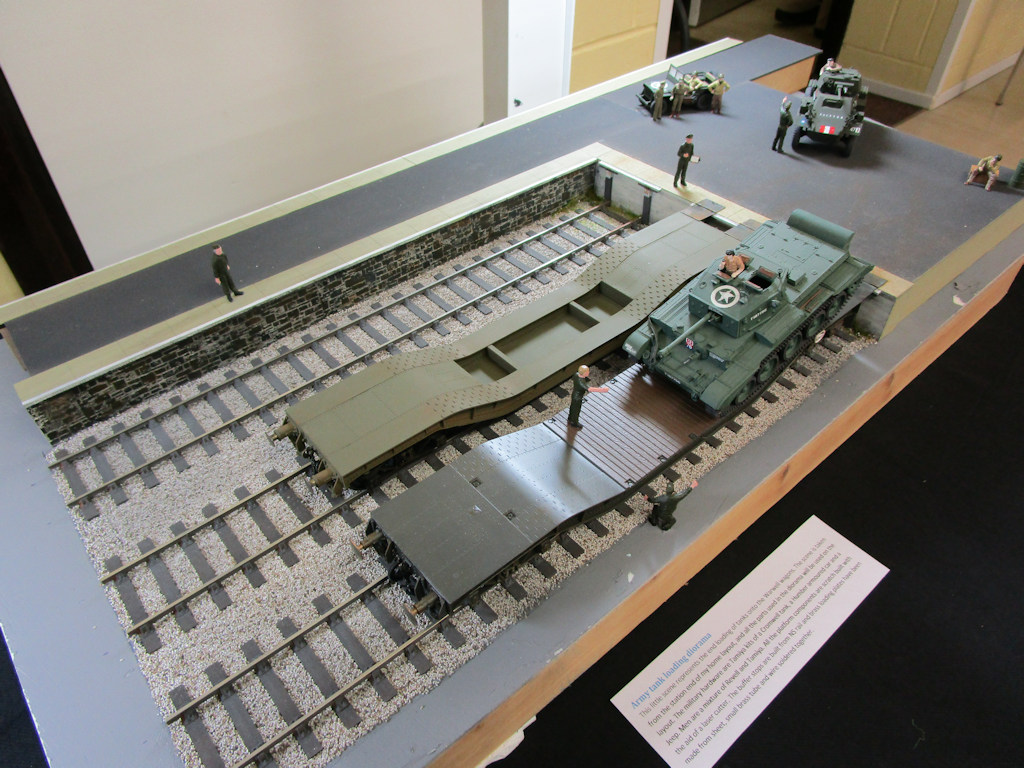
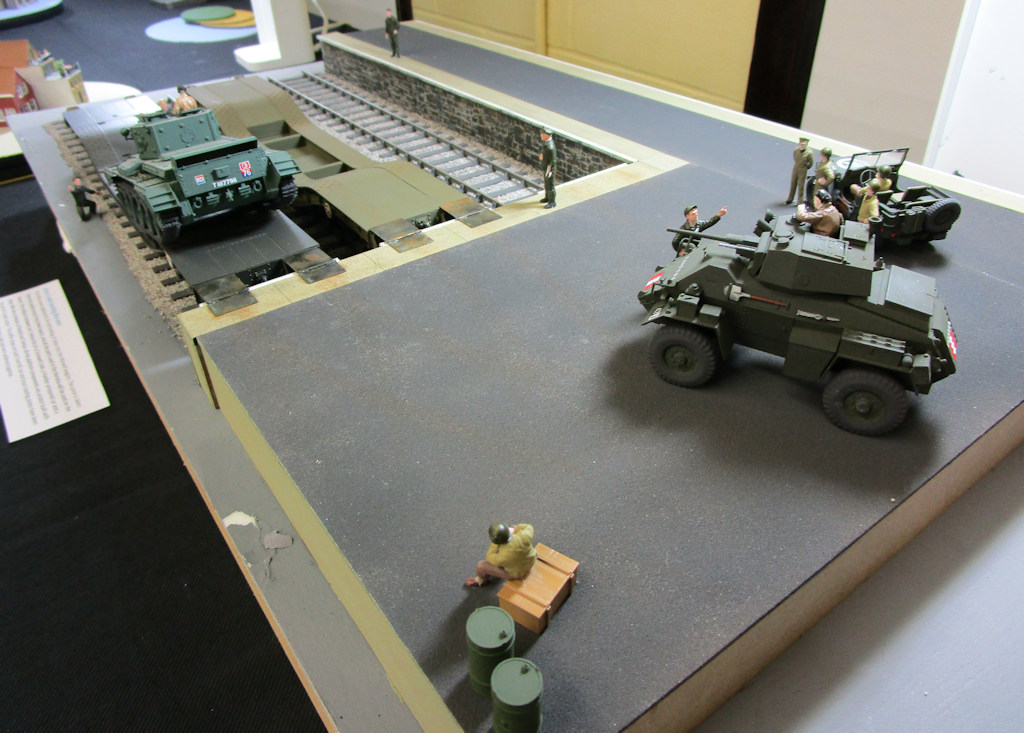 The winner of the Dioramas & Figurines category was James Aitken for his Army Tank Loading Diorama. This little scene represents the end loading of tanks onto Warwell wagons. The scene is taken from the station end of my home layout, and all the parts used in the diorama will be used on the layout. The military hardware are Tamiya kits of a Cromwell tank, a Humber armoured car and a jeep. Mem are a mixture of Revell and Tamiya. All the platform components are scratch built with the aid of a laser cutter. The buffer stops are built from NS rail and brass loading plates have been made from sheet, small brass tube and wire soldered together.
The winner of the Dioramas & Figurines category was James Aitken for his Army Tank Loading Diorama. This little scene represents the end loading of tanks onto Warwell wagons. The scene is taken from the station end of my home layout, and all the parts used in the diorama will be used on the layout. The military hardware are Tamiya kits of a Cromwell tank, a Humber armoured car and a jeep. Mem are a mixture of Revell and Tamiya. All the platform components are scratch built with the aid of a laser cutter. The buffer stops are built from NS rail and brass loading plates have been made from sheet, small brass tube and wire soldered together.
Aylesbury Town 4mm Model Project
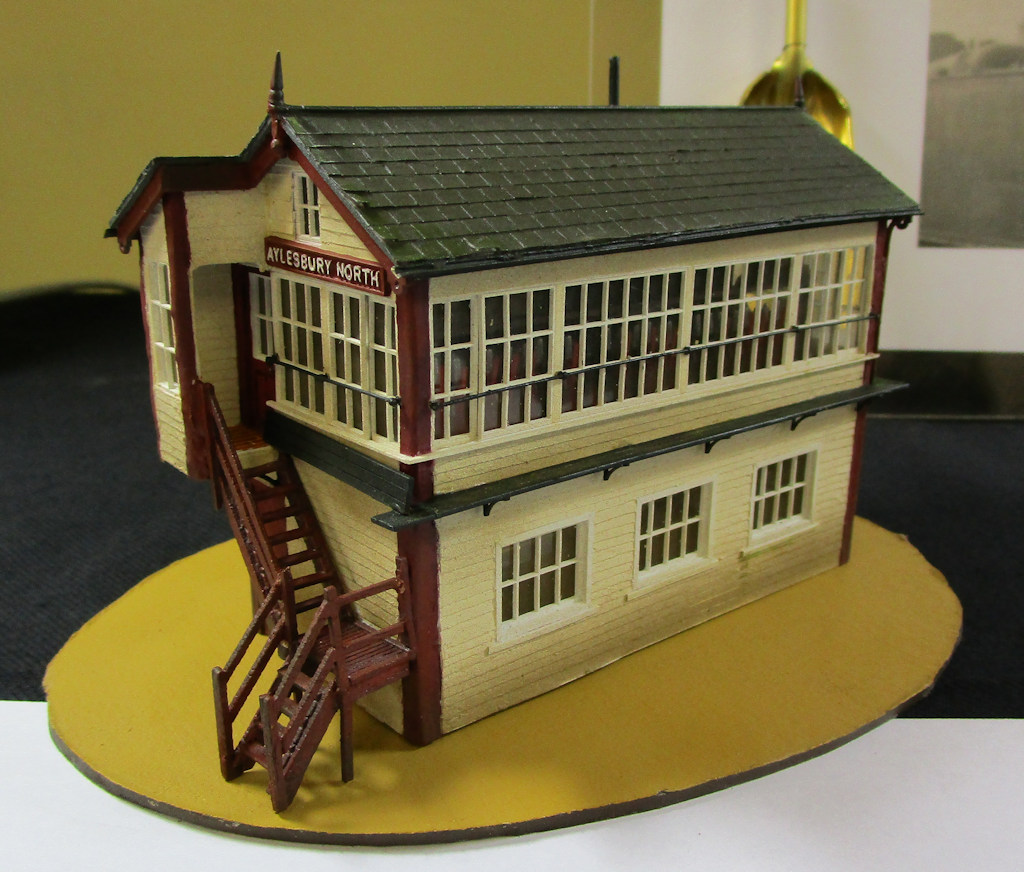 The winner of the Robin Lane Memorial Trophy for the best Aylesbury Town 4mm Model was Gary Day for his Aylesbury North Signal Box. This is a 4mm = 1ft scale scratch built model. The structure is Laser cut Romark, The steps are a modified Ancorton Models kit and the interior is from Ratio.
The winner of the Robin Lane Memorial Trophy for the best Aylesbury Town 4mm Model was Gary Day for his Aylesbury North Signal Box. This is a 4mm = 1ft scale scratch built model. The structure is Laser cut Romark, The steps are a modified Ancorton Models kit and the interior is from Ratio.
